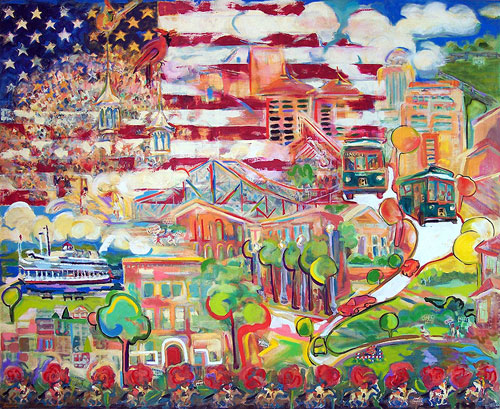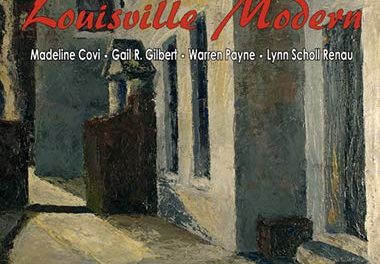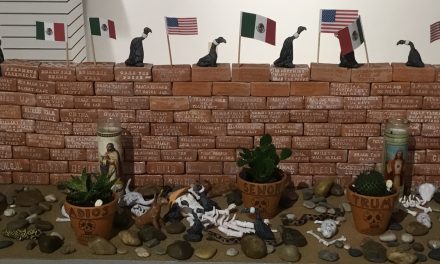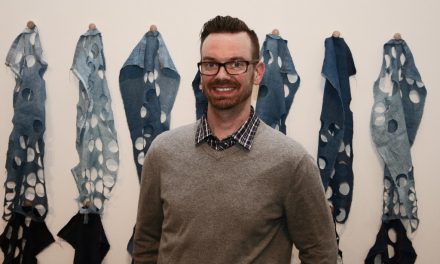Photo-garner narrative
100 Burning Boats
sculpture by Philip Campbell
Review by Keith Waits
Entire contents are copyright © 2014, Keith Waits. All rights reserved.
Among the many division of categories one can apply to art; and first let us be reminded that such labels are useful for such discussions but are too often impediments for honest viewing, the broader choices might be said to include ancient and modern, intellectual elitism and populism, sophisticated and primitive. Nowadays many educated artists use primitive forms in sophisticated ways which blur the distinctions, begging the question -is primitivism so employed still primitive?
At a glance Philip Campbell’s “100 Burning Boats” might strike one as rather ordinary objects: design lacking detail and craft lacking flourish. But the longer you examine the armada of hand-carved vessels making their way across a simple wooden flow of river, the more the deceptively simple, elemental shapes suggest deeper connotations. Louisville’s placement on the Ohio River might lead a viewer to feel satisfied with the installation as another quaint river reference, but the artist is tapping into a fundamental human spirituality that defies the usual categorizations. As an image, it calls to mind ancient mythologies and deeper history than is commonly encountered in recent cultural discourse. Viking funerals are no longer in fashion, but the burning vessels sail away from us into the unknown, the fire devouring the earthly remains now that they have no place among the living. Those left behind on the river bank continue to seek wisdom and understanding, but the souls of the departed have moved beyond such concerns, or so we imagine.
100 Burning Boats,(detail) Image-garner narrative
While viewing the installation, I did find the most compelling perspective was to look from behind the boats, and only later did I realize why it was so. So many of our touchstone images of death involve the river or bodies of water moving away from us, a journey into the mysterious Other. The River Styx, the Grey Havens in The Lord of the Rings (Tolkien the Norse scholar) the metaphor is simple and timeless, probably stemming from a more primitive time in our history when we had yet to begin so thoroughly mapping our world and the river seemed to move forever away from us. Mr. Campbell has a very personal foundation for his choices here, but he achieves universality by eschewing more specific detail and stylization and sticking to his thoughtful primitivism.
There is also a range of wood materials employed that underscore the effect, although most viewers will not be privy to the deeply felt, almost intuitive understanding that the artist expresses for the various natural elements without benefit of personal contact. But make no mistake, any randomness in exactly what types of wood are used speaks to fate and connectivity less than coincidence. The artist can pick up any one of the 100 boats and talk with detail and feeling about the materials and the experience of creating that particular vessel. They are almost all wood but a soft stone or two can also be found. Perhaps one aspect of the contemporary primitivism for working artists is that relationship to material. Mr. Campbell carves, or “whittles” the raw blocks of wood to accomplish his forms, which might be argued to be about as intimate an interaction with materials as can be imagined. The knife a simple extension of the hand, and any sophistication a reflection of that action – the intent of the artist.
Dec. 6, 2013 – Jan. 31, 2014
gallery hours Wednesday-Saturday 1-6,
First Friday Gallery Hops 1-9, and by appointment
garner narrative
642 E. Market St.
Louisville, Kentucky 40202
502.641.8086
garnernarrative.com





